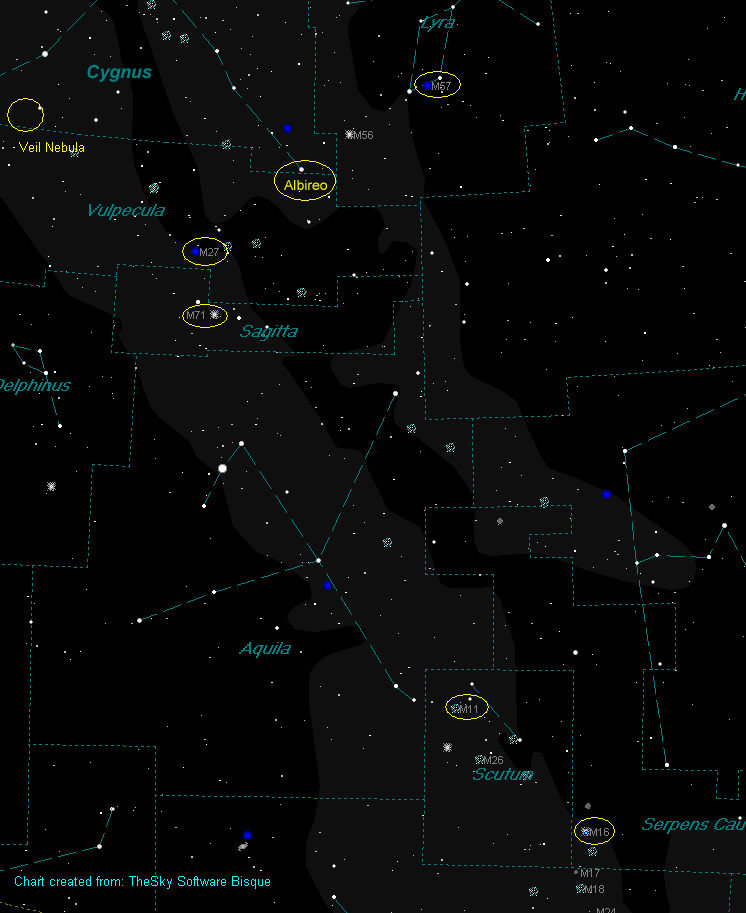Summer Time Treats part 2
Continuing our tour of the night sky, we now exit the constellation Sagittarius to pick up the next target in Scutum – home of the great Scuti Star Cloud. From the Swan Nebula where we left off last month, move two and a half degrees northward to the Eagle Nebula. Catalogued as Messier 16, the Eagle is yet another emission nebula slowly giving birth to new stars. One of the most iconic images taken by the Hubble Space Telescope occurred on April 1, 1995, when the orbiting telescope set its sights on the middle of this vast nebula. Dubbed the “Pillars of Creation”, the Hubble delivered unprecedented sharpness and subtle detail with numerous Bok globules – black patches of gas and dust that could form stars. The Eagle Nebula is about 7,000 light-years (ly) away and at magnitude 6.4 is just within naked-eye detection.
If you own a pair of wide-angle binoculars and observing under dark skies, move up to the huge patch of light. This cloud is a vast collection of distant stars known as the Scuti Star Cloud. Located at the northern edge of the cloud and some 6,000 ly away is the “Wild Duck”. The lovely backdrop of the fog from starlight adds to the overall observation. This is a beautiful open cluster containing an estimated 500 stars brighter than 14th magnitude. M11 would be a fantastic object for astrophotographers.

The main star of Aquilla is the star Altair. Nicknamed the “sweet sixteen star” due to the fact this quickly spinning sun resides 16 ly from us. Altair spins at an incredible 210 km/sec compared to the Sun’s mere 2 km/sec. Altair is also part of the summer triangle along with the star Vega in the constellation Lyra and the end star of Cygnus the Swan named Deneb. Moving northward from Altair to Sagitta the Arrow, we come across a fantastic open star cluster catalogued as M71 or NGC 6838. It resides 13,000 ly away and glows at magnitude 8.2. Its apparent size is a quarter that of the full moon.
Next, we take a look at the head of Cygnus the Swan. Albireo is deemed the most beautiful double star in the entire sky. The most striking part of Albireo is its colours of blue and gold when seen at any magnification in a telescope. This double star is located 385 ly away and astronomers are not sure if they orbit each other. However, if they do, estimates of a 100,000-year rotation are proposed. Alberio can be seen as a magnitude 3.4 star found halfway between the stars Vega and Altair.
Not too far south of Alberio is the Dumbbell Nebula. M27 is the death of a star which is called a planetary nebula. These stars about the size of our sun do not blow up in a spectacular supernova but graciously balloon out to become a red giant with the outer shells of atmosphere escaping into space to create beautiful celestial portraits, a fate that awaits our Sun about five billion years from now. M27 is only 1,250 ly away and is listed as magnitude 7.4. At first glance, the Dumbbell looks like an eaten apple core but long exposures bring out the subtle fainter structure on its other axis. Another planetary is the Ring Nebula in the constellation Lyra. M57 resides twice as far as the Dumbbell, is a magnitude fainter but is a lot smaller. It measures 1.4 X 1 arc minutes in size compared to 8.0 X 5.7 arc minutes for the Dumbbell. In all cases of planetaries, the central star called a white dwarf is barely visible visually.
Our final object of the summer Milky Way tour is also a bit of a challenge. The Veil Nebula is the faint remains of a once bright star. Some 5,000 years ago that star came to its end of life and after fusing lighter elements into heavier ones met its end when it formed iron. Now the fusion process ended and the star quickly implodes to a point and a couple of seconds later explodes into the most powerful firecracker in the sky thus releasing it’s newly made elements. Over billions of years, new stars can be created from this gas and dust. The best guess astronomers have given its distance at about 1,400 ly. There are many subtle and delicate parts of the Cygnus Loop to which the Veil is one portion. The overall size of this expanding region is six times the width of the full moon.
The yearly Perseid is slated to peak this year for the night of August 11/12. The good news is the moon sets before 1 a.m. on the 12th so you should have a few hours of wonderful meteor watching. Plan to take advantage of campgrounds to watch this cosmic show that produces more than 100 meteors per hour striking the atmosphere at 74 km/sec. The parent comet for this shower is Comet Swift-Tuttle.
The three planets are still favourites at public star parties but set your sights on Jupiter as it now sets at 10 p.m. local time on August 1. Mars then disappears behind the western horizon an hour and a half after Jupiter with Saturn an hour after that. Venus and Mercury are very low in the west after sunset. For most of the month, you can see all five visible planets.
The new moon occurs on August 2 (lunation 1158) and the full Sturgeon Moon occurs at 9:27 UT on August 18. And lastly, you can begin looking for the zodiacal light in the east before dawn breaks at the end of August. Here we see interplanetary dust particles lit by the Sun. This also continues in September until moonlight interferes.
Until next month, clear skies everyone.
Twitter: @astroeducator
